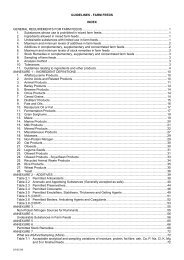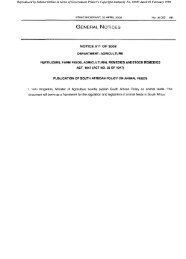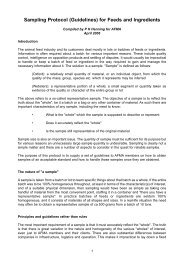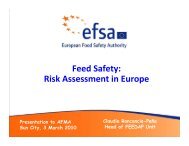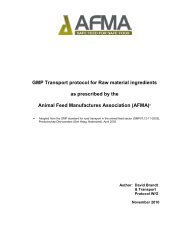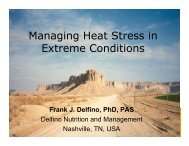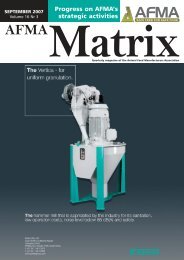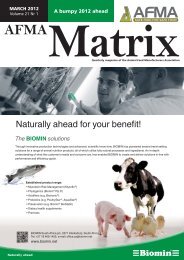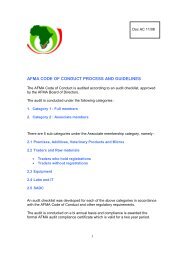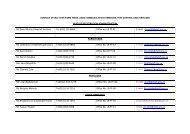You also want an ePaper? Increase the reach of your titles
YUMPU automatically turns print PDFs into web optimized ePapers that Google loves.
ing heat stress, would be helpful. Minerals<br />
can be provided from high bio-available<br />
sources like complex trace minerals, Zn,<br />
Cu, Mn and Cr. This would also help to reinforce<br />
the immune system and reduce infectious<br />
problems (Tomlinson et al., 2008). By<br />
providing sodium bicarbonate to replenish<br />
the carbonates lost in the urine would also<br />
prevent metabolic acidosis.<br />
It is desirable that animals have the<br />
benefit of being exposed to lower temperatures<br />
during night time. Despite high<br />
ambient temperatures during the day, a<br />
cool period of less than 21⁰C for three to<br />
six hours will minimise the decline in milk<br />
yield (Igono et al., 1992).<br />
Poultry<br />
When chickens are exposed to hot weather,<br />
they seek comfort in the house, stop eating<br />
and pant. Birds do not have sweat glands<br />
like mammals and the body is covered by<br />
a thick feather cover. They display ruffled<br />
feathers when kept under these conditions<br />
(Daghir, 1998; Reece et al., 1972). Panting<br />
starts off by being fast and superficial, but<br />
if exposure is prolonged it becomes deep<br />
and slower and then respiratory alkalosis is<br />
developed. Capillary beds are dilated.<br />
The immune response is compromised<br />
during heat stress (Gross & Siegel, 1983; Lin<br />
et al., 2005; Tirawattanawanich et al., 2011),<br />
so care must be taken to avoid exposure<br />
to infectious agents. Mortality can happen<br />
within minutes once birds have reached<br />
this point of alkalosis and hundreds or<br />
thousands of birds can die. Performance<br />
losses in these birds reaching market age<br />
include poor performance and losses in<br />
processing plant yield (Ryder et al., 2004;<br />
Renaudeau et al., 2011).<br />
The following approach classifies the<br />
actions to be taken considering the target<br />
objectives pursued to minimise losses during<br />
heat stress:<br />
Reducing body heat production<br />
Reducing stocking density is strongly<br />
recommended in hot climates – below<br />
35kg/m 2 in cases of tunnel ventilated<br />
houses and below 12 birds/m 2 (25kg/m 2 )<br />
in open-sided houses. During the brooding<br />
phase, try to give birds full access to<br />
the space of the house.<br />
Proteins in the diet cause the highest<br />
heat increment, so accurate amounts are<br />
recommended according to feed consumption,<br />
providing a good amino acid<br />
balance (Daghir, 1998; Lu et al., 2007).<br />
Feed restriction is probably the most<br />
used practice in broilers to avoid mortality<br />
(Daghir, 1998; Zulkifli et al., 2000). It is<br />
mostly used in non- or incomplete technified<br />
operations. Tunnel ventilated houses<br />
do not use it unless facing an unusual<br />
situation. It is recommended mostly during<br />
the beginning of the hot season when<br />
birds are being exposed to heat during the<br />
first few weeks. Feed access is removed<br />
for six hours during the peak hot time and<br />
then two hours of light during the night<br />
are given to compensate. Midnight feeding<br />
is also practiced with broilers, especially<br />
in open-sided houses (Daghir, 1998;<br />
Renaudeau et al., 2011).<br />
Increasing airflow<br />
New production systems consider the use<br />
of tunnel-ventilated houses with negative<br />
pressure provided by a set of fans<br />
(132cm) on one extreme of the building<br />
that pull the hot stale air out. The air enters<br />
the building on the other extreme of the<br />
building through a filter that can be wet<br />
or dry, depending on the need of the micro-environment<br />
inside the house (Lacy &<br />
Czarick, 1992). Approximately 152 to 244m<br />
per minute is commonly used in these kinds<br />
of houses (Lacy & Czarick, 1992). These systems<br />
imply good sealing, quality of materials<br />
and construction, as well as high-energy<br />
use (dependable power supply).<br />
Open-sided houses are still being used<br />
in tropical countries and in some cases performance<br />
is efficient enough to keep in production.<br />
These systems exploit the adaption<br />
process of the chicken. However, in the case<br />
of a heat wave that exceeds the adaption<br />
limit, big mortalities may occur. In this case<br />
the money saved by cheaper facilities and<br />
lower energy consumption is exceeded by<br />
the losses. Many layer farms have these systems<br />
with some comfort provided by some<br />
fans and sprinklers/foggers.<br />
Evaporative heat loss<br />
The use of wet panels in the inlets of poultry<br />
houses is a common practice. The comfort<br />
sensation when humidity is incorporated<br />
increases substantially. The use of foggers<br />
is also very common at the peak time of<br />
hot weather condition. In dry hot weather,<br />
this evaporative cooling is essential and accounts<br />
for the main heat loss mechanism.<br />
Soaking of birds is not a common practice,<br />
but it is still done in some hot weather<br />
producing areas. It is done manually as an<br />
emergency measure and it has shown good<br />
results.<br />
Compensating for negative effects<br />
Full water access must be provided as birds<br />
increase water consumption during hot<br />
weather. A major problem in poultry production<br />
is the reduction in feed intake, but<br />
also the reduced efficiency derived from<br />
the compensation process in the body.<br />
As mentioned, from a nutritional standpoint<br />
some changes in the diet have proved<br />
to provide great value: Increase in nutrient<br />
density, replace as much energy as possible<br />
by fat sources, improve amino acid balance,<br />
increase vitamins E, C and A, as well as trace<br />
mineral fortification. Do not increase protein<br />
– just provide a good amino-acid balance,<br />
as an increase in protein has proved<br />
to increase fat deposits in the carcass.<br />
The use of electrolytes in water also<br />
helps to replace the main ions lost. Solutions<br />
of NaCl and KCl can be added when<br />
heat waves are hitting.<br />
Acclimation to high ambient temperatures<br />
happens to animals chronically exposed<br />
to hot weather conditions (Yalçin<br />
et al., 2000; Yahav & McMurty, 2001; Yahav,<br />
2009). It consists of anatomical and physiological<br />
changes developed by the body<br />
of the animal to reduce heat production<br />
and increase heat loss, preventing a longer-term<br />
exposure. Studies need to be done<br />
to learn to what extent the animals can be<br />
tested, the type of acclimation processes<br />
and the nutritional plane they would require.<br />
Given the physiological adaption processes,<br />
profitable and competitive performance<br />
still needs to be obtained. Providing<br />
maximum comfort can become extremely<br />
costly to achieve. However, taking advantage<br />
of some adaption process could help<br />
to make production feasible in tropical and<br />
subtropical countries.<br />
References are available from <strong>AFMA</strong> on<br />
request.<br />
Processing<br />
<strong>AFMA</strong> MATRIX ● APRIL <strong>2013</strong> 21



